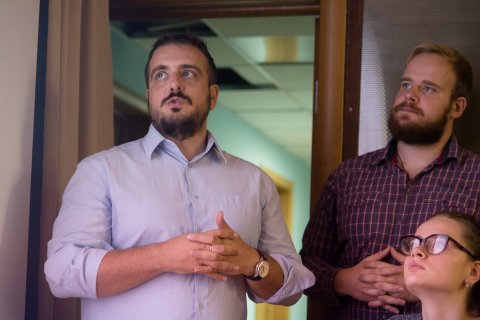On October 9th, the Laboratory of Experimental Archaeology of the Eurasian Studies Research and Education Centre and the SUSU Department of Russian and International History presented the EXARC grant project, “Sintashta Bow Project”, at the State Museum of South Ural History.
This project is being fulfilled by archaeologists from SUSU and the Archeos Experimental Archaeology Association, alongside the Koryvantes Association of Historical Studies from Greece. The aim of the project is to reconstruct a composite bow of the Sintashta culture using materials from the Kamenny Ambar-5, Stepnoe-M, and Solntse II burial sites.
The presentation was offered by the head experts of the project: Ivan Semyan, Head of the SUSU Laboratory of Experimental Archaeology, Director of the Archeos Experimental Archaeology Association and member of EXARC, and Spyros Bakas, a researcher from University of Athens and University of Warsaw, Head of the Koryvantes Association of Historical Studies and EXARC member, Greece.

Specialist in bronze age warfare and scientific advocate Ivan Semyan spoke about the joint Russian-Greek grant project and shared his experience on the development of ancient technologies of arrow production, field tests of recreated historical objects, popularization of non-mainstream archaeological reconstruction, and working with children, as well as shined a light on the secrets of warfare of the bronze age in the South Ural region.
“The goal of the project is to recreate one of the ancient composite bows of the Bronze-Age Sintashta culture. The project is complicated in that only separate components made of horns, which survived until our time, have been found. Based on these components, and also based on the physical capabilities and physical characteristics of the stone and bronze arrowheads found in graves, we are reconstructing the morphology of the bow, its mechanical properties, and the arrows themselves. This is a very complex process, because it involves various technologies: working with wood, horn, silicon cleavage, and archaeological metallurgy. This wide spectrum of paleotechnologies requires a multidisciplinary approach and the involvement of various specialists,” said Ivan Semyan.

Spyros Bakas, an experimental archaeologist, practicing sports archer, and a recognized expert in long-range weapons of the Bronze Age explained the reconstruction and popularization of archaeology in the modern world, the use of multimedia technologies, and talked about the current grant project in an accessible and entertaining way.
“In Greece, experimental archaeology is not very developed and there aren’t many researchers working in this field. But I hope for the success and development of this field in the future. I am happy to work with my colleague Ivan Semyan from Chelyabinsk. The experience of Russian experimental archaeologists is very valuable for Europe and can be used for future projects,” shared Spyros Bakas.
During the presentation, the guests learned about the history of the appearance of one of the oldest compound bows and about the newest research projects in Russian and Greek experimental archaeology. The lecturers spoke about the unique qualities of the bow under study, which has no analogues among finds of this kind with similar morphology. They also spoke about why this bow was chosen for reconstruction.

At the end of the lecture portion, a master class was held, during which the attendees were able to create a stone arrowhead using ancient technologies and authentic materials, thus holding an archaeological experiment of their own. Maria Kazakova, a student of the SUSU Faculty of History, spoke about creating an arrowhead:
“Right now we are trying to reconstruct an arrowhead using the pressure flaking technique. You take a flake (flint) and by using a pressure flaking instrument, you make an arrowhead out of flint. A flake tool is a handle with a sharpened “tooth”. I like the idea of the master class, it’s unfortunate that we didn’t have such classes at school. The lecture was also interesting and informative; it is important for student historians to be aware of the events of modern archaeology and, in addition, this can be useful in our work in the future.”
Taking bearings from the large amount of experience of their Greek colleagues and the relevance of this research for the South Ural region in the fields of reconstructing and testing metal weapons, archaic forms of armour and chariots, the researchers are hoping to continue their cooperation in studying warfare and military culture of the Bronze Age.




